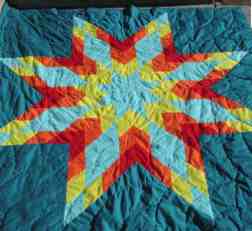 The same book on the language of toys offers this activity for using a blanket to teach language. This is a perfect toy and activity for many of our reservation families. Generosity is a part of being a Native American. Friends and relatives do want to help families who have a small child with special needs. If you cannot sew yourself it is almost certain you have an auntie, a grandmother or friend who makes star quilts. Ask her to help you with this project. When you explain the purpose is to help your child, and how the blanket will be used, any relative who likes sewing will be able to give you good advice on what types of fabrics to use.
The same book on the language of toys offers this activity for using a blanket to teach language. This is a perfect toy and activity for many of our reservation families. Generosity is a part of being a Native American. Friends and relatives do want to help families who have a small child with special needs. If you cannot sew yourself it is almost certain you have an auntie, a grandmother or friend who makes star quilts. Ask her to help you with this project. When you explain the purpose is to help your child, and how the blanket will be used, any relative who likes sewing will be able to give you good advice on what types of fabrics to use.
“To make this blanket, visit the local fabric store and look through their remnant basket. Choose a variety of different textures. You should only need one-fourth to one-half yard of each fabric you want to use. ....Take your materials home, wash each of the fabrics, cut them to the shapes that you want, and sew them together. You will enjoy putting your baby on this blanket and allowing her to experience each of these textures. When you have playtime, lie down with her and talk about each of the different materials that you used. What a treasure for you to keep for your infant as she gets older and can understand that this was made just for her.
“Oh, would you like to lie down on this nice blanket? Look over here. This is a nice soft blue piece of fabric [take her hand]. Can you feel how soft it is? It feels so nice and furry. Ooooh, soft! Look at this red part over here. This is corduroy and it feels bumpy. Can you feel how bumpy it is?….”
Continue with each of the textures that appear on the blanket. Choose words that accurately describe the feel of the material. Don’t be afraid to use the actual names of the fabrics when introducing the various textures to your child. Remember, she needs to acquire language receptively before she can expressively communicate back to you. When you label corduroy “rough” as opposed to the satin “smooth,” your child gains an understanding of these words as she feels the textures. This kind of sensory impression will help her understand the concept and remember it the next time you use the words “rough” and “smooth.”